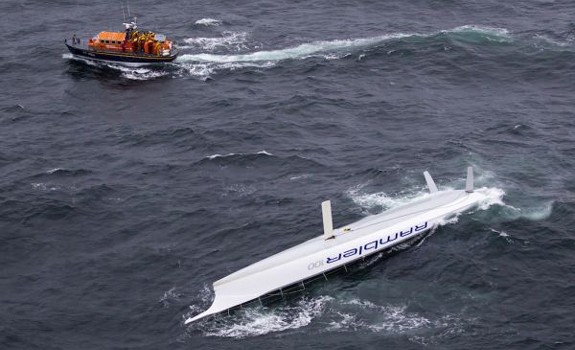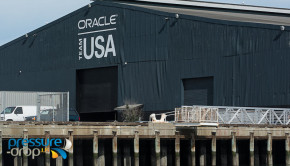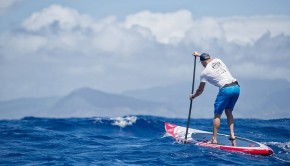Peter Isler – Surviving to tell the story of Rambler 100
Published on August 16th, 2011
 Surviving to tell the story of Rambler 100
Surviving to tell the story of Rambler 100
It was Monday (Aug. 15), and the Juan K designed Rambler 100 had but 265 miles remaining in the 608 mile Fastnet Race. They had just rounded the infamous Fastnet Rock, and needed to complete a short 7 mile beat before they could turn left and enjoy the hayride home. But then, at 5:45pm UK time, the unthinkable happened: the keel bulb broke off.
Here Rambler 100 navigator Peter Isler shares his story from onboard:
In 23 knots of wind, we were headed upwind after rounding Fastnet, and heard the big bang. The boat immediately flipped to 90 degrees, and within 30 seconds it turned turtle. Five people got separated from the boat. They luckily all had life jackets and were able to stay together. The remaining 16 crew were able to stay with the boat, three of which did the dry walk onto the overturned hull. Everyone had their own harrowing story to get up on the hull.
We then waited almost three hours, during which time we saw the Farr 100 Leopard go by maddeningly close and the Volvo 70s pass by at a little greater distance. Then a lifeboat came out, which was responding to one of the two personal EPIRBs that Mick Harvey and I had carried in our pockets. But they came maddeningly close but did not see us. After they did a search pattern for about 45 minutes they found us.
We then notified the rescue team of the five crew that were separated from the boat, which a second rescue boat then located. Everyone was extremely cold, which included owner George David and his partner Wendy Touton, who was hypothermic and was airlifted for treatment.
The remaining twenty of us were then taken to the incredible Baltimore Sailing Club where in very short order the club members had put together a dinner, a stack of dry clothes, and two nice big houses to accommodate us, and the most incredible small town welcome you could ever hope to get.
On determining the problem…
It was immediately apparent what happened. Despite being in the nav station, I could easily tell that the boat was on its side. It couldn’t be anything else but a keel issue. Luckily I had all my gear on, including my lifejacket. I immediately called mayday on the main ship’s radio, but I didn’t get a response, so I picked up the handheld and started calling. The sails and rig had helped to keep the hull on its side, but during this second call the boat turtled.
I am still in the nav station, with a big jump and a swim to go. Luckily, there was an air bubble in the cockpit, so when I exited the hatch I was able to get a final breath before my big swim out from under the boat. I knew I had to get really deep because the boat was going up and down in the waves, and I had to clear the lifelines. I swam for all I was worth, but once I was clear of the lifelines I had ran out of air.
All I had to do now was surface, but I was so weighted down with my gear that the life jacket was not pulling me up too fast. I finally saw two dark shapes, and reached for what turned out to be boots. As I did, a hand reached out and Andrew Taylor pulled me up and I grabbed one of the nicest breaths of air I have ever had.
On the boats that passed you…
Visibility was down to ¾ mile with intermittent rain showers. Leopard passed us at about a 400 meter distance, but they were in the process of reefing and I suspect had their hands full at the time. Nobody noticed we had a problem until the EPIRB signal was picked up. It was about 45 minutes after the EPIRBs were activated when the Royal National Lifeboat Institution got the message that we needed help. This is a volunteer organization, and they were luckily out at Fastnet Rock taking pictures of the race. So they were relatively close to us, and the EPIRB brought them to our Lat/Long coordinates.
On the race tracking…
Competitors can track each other through the website tracking like is done by the home viewer. With a good internet connection, we can get an update every 30 minutes. The section of the race we were on was a short non-tactical beat before we turned for the finish, and given the conditions, tracking the fleet wasn’t something we were worrying about. I doubt our competitors were either. We were required to have our AIS on, but we rarely saw Leopard’s AIS signal, so they likely did not see ours either. We are not required, that I know of, to have our AIS antennae at the top of the mast, but that would be a really good idea. We can see cargo ships at a great distance because their antennas are positioned high, but the race boats all have their antennas low for weight, which makes them less effective.
On what saved your crew…
There were a bunch of fortunate things that led to the successful rescue of all 21 crew members. We all had our life jackets on, and those that could stay with the boat did, and those that couldn’t stayed with each other in the water. Being close to Fastnet Rock, the lifesaving boat was not far away. Since we had just rounded the rock and put a reef in, most of the crew was on deck rather than half of them in the bunks.
The crew was manned by some of the strongest and most experienced crew in the world. A lot of the crew had gone through the Volvo Ocean Race required safety training, which has gotten better and better. A whole bevy of decisions were made very quickly and very correctly.
On lessons learned…
Every time you go through something like this you learn things, but no amount of training can completely prepare you for it.
None of this was easy. It was hard to hold onto the boat; it was hard to even get near the boat. Waves were pushing the boat around, and waves were shooting from the boat. Getting out of the water and on the boat was hard. Luckily we had rope, and that both Mick and I had our EPIRBs. Without the EPIRBs, nobody would have known about us for who knows how long.
While everyone had their inflatable lifejackets on, we didn’t all have our crotch straps fastened which makes the lifejacket much more effective and comfortable in the water.
The way our liferafts were stowed, on deck and right at the transom, could not be accessed with the boat flipped. It would have taken a superhuman effort to release them, and then pull them under water to clear the lifelines and up to the surface. We thought about it… in the rafts was a full assortment of safety gear to help sustain us and assist in our rescue. But we decided that it couldn’t be done.
On being under boats…
I think a lot about the young girl (Olivia Constants) who died this summer in Annapolis after capsizing a Club 420. Being on a boat, turning turtle with a lifejacket on, and envisioning an escape. How hard can it be? Well, it’s hard. The chance of getting tangled within the lines, getting hit by the motion of the boat, are real. All of us on Rambler 100 are very thankful for surviving this incident.










 We’ll keep your information safe.
We’ll keep your information safe.